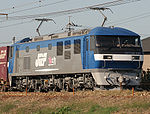- JNR Class EF55
-
EF55 
EF55 1 at Matsumoto Station, October 2003 Power type Electric Builder Hitachi, Kawasaki, Tōyō Electric Build date 1936 Total produced 3 AAR wheel arr. 2-C+C-1 UIC classification (2'Co)(Co'1) Gauge 1,067 mm (3 ft 6 in) Driver diameter 1,250 mm (4 ft 1 in) Trailing wheel
diameter860 mm (2 ft 10 in) Length 19,150 mm (62 ft 10 in) Width 2,810 mm (9 ft 3 in) Height 3,810 mm (12 ft 6 in) Locomotive weight 100.38 t Electric system 1,500 V DC Top speed 75 km/h (47 mph)[1] Power output 1.350 MW (1,810 hp) Tractive effort 6,300 kgf (61,780 N; 13,890 lbf) Career JNR, JR East Number in class 3 Delivered March 1936 Disposition All withdrawn The EF55 class of 2Co+Co1 wheel arrangement electric locomotives consisted of three locomotives built in 1936 by Hitachi, Kawasaki, and Tōyō Electric in Japan.[2]
They were originally intended to haul limited express trains on the Tōkaidō Line. Although based on the earlier EF53 design, the EF55s featured a unique non-symmetrical wheel arrangement with a streamlined cab at only one end. The number 2 end had a traditional-style cab with access deck.[1]
The need to turn locomotives in regular use proved to be the downfall for this small class, and the locomotives were placed in storage from 1958, and then officially withdrawn in 1964. Following withdrawal, EF55 1 was moved to the former Chūō Railway Institute near Nishi-Kokubunji Station for apprentice training purposes. EF55 3 was cannibalized to donate motors and other components to the ED30 prototype AC electric locomotive, and EF55 2 was also cut up shortly after. In 1978, EF55 1 was designated as an important piece of railway heritage, and was subsequently restored to running condition, re-entering service in 1986 for use hauling special event trains. It was operated by JR East, based at Takasaki depot, until it was finally withdrawn in December 2008.
They were nicknamed "Moomin".
References
Japanese Railway Locomotives Steam locomotives 
Diesel locomotives Electric locomotives EB10 • ED18 • ED60 • ED61 • ED62 • ED70 • ED71 • ED72 • ED73 • ED74 • ED75 • ED76 • ED77 • ED78 • ED79 • EF15 • EF30 • EF50 • EF51 • EF52 • EF53 • EF55 • EF56 • EF57 • EF58 • EF59 • EF60 • EF61 • EF62 • EF63 • EF64 • EF65 • EF66 • EF67 • EF70 • EF71 • EF80 • EF81 • EH10 • ED500 • EF200 • EF210 • EF500 • EF510 • EH200 • EH500 • Seibu E31 • Seibu E851 • Toei E5000
Categories:- Electric locomotives of Japan
- Narrow gauge locomotives
- 2-C+C-1 locomotives
- 1500 V DC locomotives
- Preserved electric locomotives
- Railway locomotives introduced in 1936
- Hitachi locomotives
- Kawasaki locomotives
Wikimedia Foundation. 2010.
